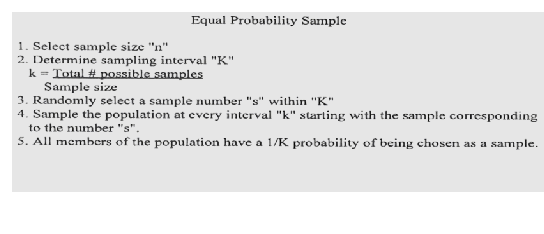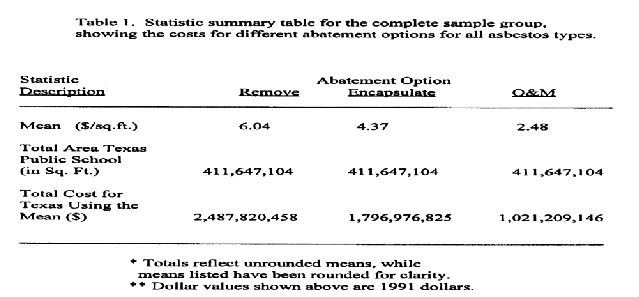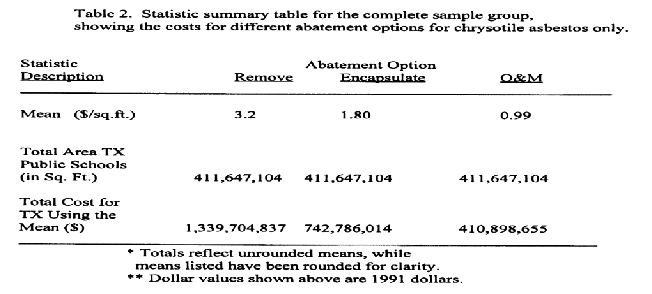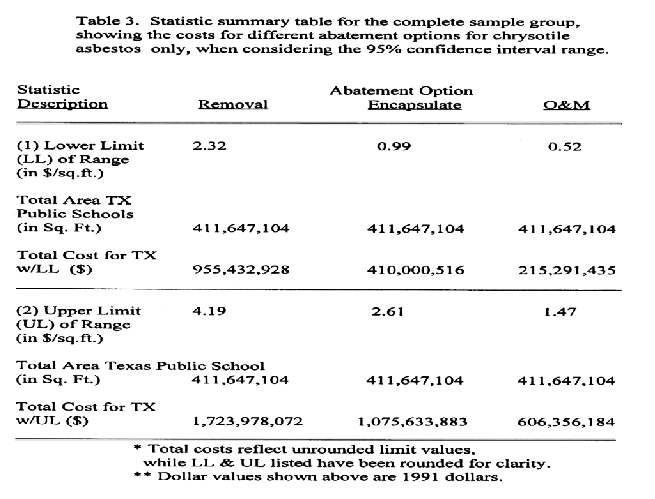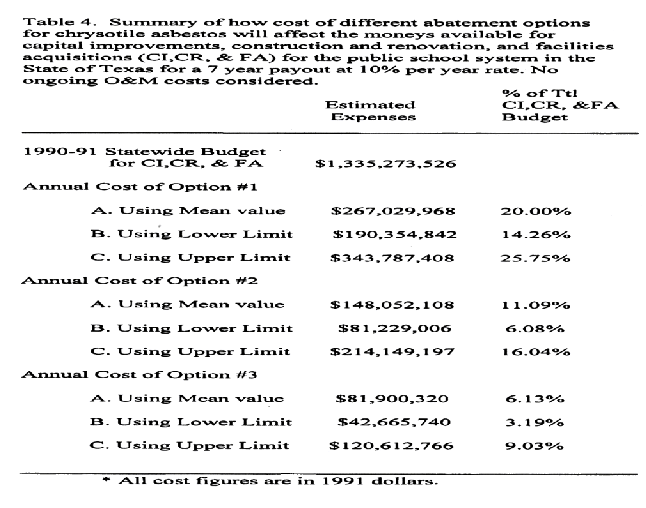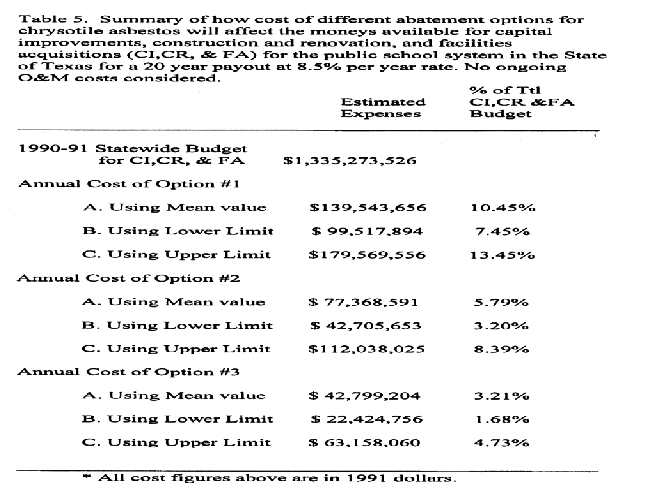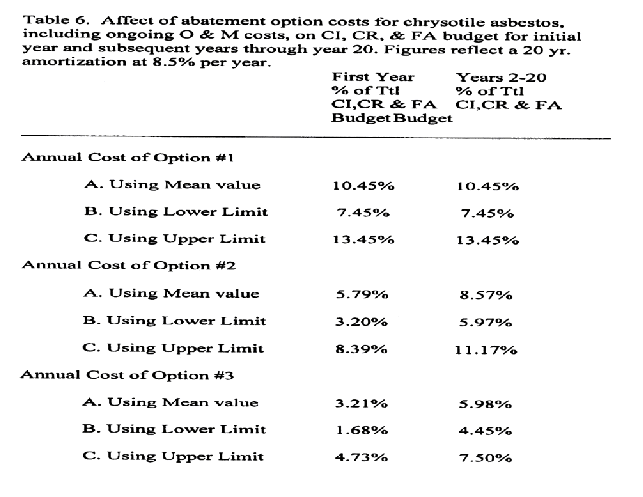|
(pressing HOME will start a new search)
|
|
Chrysotile Asbestos: Are the Costs of Mandating Actions Affecting Construction Funding?
|
John
D. Murphy Jr. Construction
Management
Fort
Collins, Colorado |
Larry Grosse Department
of Construction Science Texas
A&M University College
Station, Texas |
|
Chrysotile asbestos continues to be a point of controversy with regard to government regulation. This paper presents the results of a study which determined that earlier estimates of the financial burden of asbestos related regulations upon local education agencies has been underestimated. Furthermore, the costs associated specifically with abatement of chrysotile asbestos are shown to significantly affect the available moneys that would otherwise be utilized for maintaining the current level of educational facilities in the Texas Public School System. Therefore, this reduced availability of state funding for capital improvements greatly affects the construction industry. Keywords: Construction Funding, Chrysotile Asbestos, Cost. |
Introduction
The
Environmental Protection Agency (EPA) is charged with setting guidelines for the
protection and well being of the public. At the same time, the EPA is compelled
to "..promulgate [the] least burdensome, reasonable regulation required to
protect the environment adequately." (Murphy and Grosse 1993) (Corrosion
Proof Fittings v. EPA 1991). In all fairness, the EPA is operating within a
fiscal dilemma. They are expected to protect society, yet they are limited by
the funds available to be used to achieve this level of safety that we have all
come to expect. A case in point is the Asbestos Containing Materials In Schools
Rule of 1987 which promulgated final regulations for the Asbestos Hazard
Emergency Response Act (AHERA) of 1986. As stated in these rules, local
education agencies were, among other things, required to identify asbestos
containing building materials in school buildings and take appropriate action to
control potential fiber release. "The final rule identifies five major
response actions - in section 763.91, operations and maintenance (O&M) and
in section 763.90, repair, encapsulation, enclosure and removal..." (40 CFR
Part 763,1987). The regulations, for the most part, choose not to differentiate
between asbestos types in setting a scope. As stated in a recent issue of
Building Research Journal (Murphy and Grosse 1993) the literature does reveal a
difference of opinion with respect to the actual health risks associated
specifically with chrysotile asbestos.
There
are basically two types of fibrous asbestos, serpentine chysotile and fibrous
amphibole (Benarde, 1990). Within the amphibole group, there are several types
such as tremolite, amosite, crocidolite, and others that are less commonly used.
While there seems to be some agreement concerning health effects of the
amphibole group, there is an ongoing controversy with respect to the level of
carcinogenicity (cancer causing properties) of chrysotile asbestos. With this
debate continuing, one wonders what effect the AHERA regulations are having on
the economy. To place some value on the cost of such regulations may bring more
attention to the possibility that the EPA should continue to re-evaluate the
scope of asbestos related regulations with regard to chrysotile asbestos.
Ideally this research would include all public school buildings in the United
States. But due to obvious logistical limitations in funding and time, the focus
will be on the State of Texas. The State of Texas must fund these mandated
actions out of the state budget. Typically, these type expenditures would be
funded out of the budgets for capital improvements, renovations, and
construction. If state funds for capital improvements are greatly reduced due to
these regulations, the construction industry can/will be greatly affected with
regard to available construction funding.
Methodology
To
quantify the total costs attributable to asbestos regulations, all school
buildings had to be included in the calculations. Using an existing facilities
database, a quantitative research strategy was employed, utilizing secondary
data analysis as a source for sampling the entire population in question. An
equal probability systematic sample strategy was employed for this research.
This strategy was utilized to ensure that every public school building had an
equal opportunity, "1/K", to be selected as a sample (Nachmias &
Nachmias,1987) (Fowler, 1990). The specific procedure for this sampling method
is shown in Figure 1. The total sample number equaled 199with 165 samples being
considered responsive (enough information existed in the individual management
plans to continue). This response rate of 82.91% should be considered very
positive.
|
|
|
Figure
1. Steps for obtaining a systematic probability sample |
The
Asbestos Management Plan containing each building sample was analyzed to
quantify the amount of asbestos present in the respective building. Cost
estimating procedures associated with different asbestos containing building
material (ACBM) abatement options for each of the samples followed accepted
practices currently employed in the construction industry (Peurifoy and
Oberlender, 1989). Total costs per building sample were "reduced" to a
dollar per square foot cost factor relative to each abatement option.
Statistical
analyses were performed to facilitate generalization to the population (state)
level. For each cost per square foot number respective to each abatement option
the mean cost, standard deviation, and variance were calculated for the sample
group using a 95 percent confidence interval. Two different aspects of
statistical inference are utilized through these concepts. The first relates to
the application of the mean value as a "point estimation" for the
parameter. The second concerns the consideration of the actual range produced by
the confidence interval (Spatz and Johnston, 1989). Correlation and regression
analysis were also completed but were found to be unacceptable in predictive
value. Standard U. S. units of measurement were used in this study due to the
units of measurement used in the existing database.
Results
The
data revealed a substantial level of public expenditures that can be directly
attributed to the abatement of chrysotile asbestos in Texas Public Schools. The
question raise concerns whether the extent of expenditures significant) affects
construction funding.
Economic
Significance
In
this paper, economic significance represents the question of whether these
expenditures "noticeably" affect, or would affect, the available
fiends which the Texas Public School System requires to function properly in
terms of capita improvements and construction. Tables 1 and 2 show a summary of
the research results with regard to the different abatement options as viewed
with the point estimation statistical analysis being applied. A comparison of
the total costs respective of each abatement option for the entire Texas Public
School System shown on tables 1 and 2 reveals the following:
1.
56.43 percent of the cost for total removal of all asbestos in Texas
public schools can be directly attributable to chrysotile asbestos.
2.
41.34 percent of the cost for encapsulating all types of asbestos where
possible in Texas public schools, and instituting an O & M plan where
encapsulation is not allowed by E.P.A. regulations, can be directly attributed
to chrysotile asbestos.
3.
40.23 percent of the cost for instituting an O & M plan for all
asbestos types in Texas public schools can be directly attributed to chrysotile
asbestos.
It
should be noted that the options shown in Tables 1 through 3 were chosen for
very specific reasons. Of the possible options, the only abatement option that
is not represented in the research is "enclosure." Enclosure simply
means that the asbestos can be physically covered and "sealed" against
the possibility of fibers escaping the enclosure, thus isolating the problem. 0
& M procedures are also required with this option. The reason this option
was not considered in this research is the possibilities for enclosure designs
are infinite and to designate a specific enclosure design would possibly
overstate the cost of this option. Also, a combination of different abatement
options was not included as a possibility. While this might represent a more
realistic view of what actions a school district would actually pursue, to
address the infinite possibilities of these combinations through development of
a representative model was not possible within the framework of allowable time
and financial constraints.
|
|
|
Table
1. |
As
stated earlier, one needs to consider the confidence interval range for each
abatement option. A conservative approach might be to use the lower limit of the
respective
ranges
of cost per square foot to evaluate the cost that can be associated with
chrysotile asbestos for the Texas Public School System. On the other hand, using
the upper limit could reveal the possibility of a higher cost to the State of
Texas. To illustrate how this would change the values, Table 3 shows the cost of
each abatement option considering both the upper and lower limits of the range.
By doing this, one can see how much difference in cost can be associated with
the 95 percent confidence interval. To provide the most accurate estimate
possible in using this data, all three cost values (mean, lower limit, &
upper limit) will continue to be referred to in this paper. This permits a
broader view of the possibilities.
|
|
|
Table
2. |
The
magnitude of the above stated results is meaningless without some type of
monetary reference to establish significance. This research chooses to use the
total annual budget for the Texas Public School System as a reference by which
to measure this significance. To compare the total cost of each option to the
total state budget would be an oversimplification. To make this means of measure
more specific, the budget categories of Capital Improvements, Construction &
Renovation, and Facilities Acquisition were investigated. Any cost for abatement
activities would typically come out of one of these three budget accounts.
A
very informal survey was conducted of four separate school districts in the
State of Texas. While this may, at face value, be a small number of samples, the
individual samples were chosen specifically to include some of the largest
school districts in the state. This would be considered a non probable purposive
sample (Nachmias and Nachmias, 1987). Through this strategy, the results can
represent a large portion of the constituents in the state. The results of this
survey showed that an average of 8.23 percent of the total budget for these
school districts is attributed to these cost categories. Using this average from
some of the largest school districts in Texas, this same figure can be applied
to the state-wide total public school budget. At the time of this research,
state wide values for total annual disbursements were available for the fiscal
year 1990-91. These data were obtained from the report Snapshot '91: 1990-91
School District Profiles (Texas Education Agency, 1992). The total disbursement
amount shown for Texas public schools for the year 1990-91 is $ 16,224,465,688.
After applying the 8.23 percent factor, it can be said that approximately
$1,335,273,526 of the state-wide budget is available for capital improvements,
construction and renovation, and facilities acquisition.
|
|
|
Table
3. |
As
stated earlier, the question to be considered is whether, or not, costs
associated with chrysotile asbestos abatement significantly affect the available
capital for operating and maintaining Texas public schools. Such a significant
affect would in turn affect funding for "public school construction."
This research chooses to set five (5) percent as the significant level of the
affected budget. This evaluation of significance, however, requires views of how
these costs might be financed. The first view can be considered the
"private business" approach to financing. For this view it is assumed
that any asbestos abatement costs are financed on a seven year amortization at
an interest rate of ten percent per year. While some might argue that a five
year payout is desired, a seven year payout can be considered a normal
expectation for private industry investments. These assumptions are made in
calculating the figures in Table 4, which is a summary that reveals how the
different abatement option costs would affect Texas public school budgets in
terms of a percent of the annual available funds. This table and these
calculations, assume that the state-wide budget figure for 1990-91 is
representative of the annual budget amount for the financing period. With this
assumption, the annual payments for the above referenced financing scenario can
be compared to this total annual budget amount.
|
|
|
Table
4. |
The
second view of how these abatement actions might be financed follows what is
considered by many to be a typical public school capital improvement financing
scenario. For this consideration, Table 5 reflects figures that consider a
20year amortization at an annual interest rate of 8.5 percent.
|
|
|
Table
5. |
Before
discussing the results illustrated in these tables, one fact needs to be
addressed. At this point, only the first year costs and their associated
amortization of each abatement option have been addressed. With options #2 and
#3, there exists a need for an ongoing operations and maintenance (O&M)
program as stipulated by the EPA regulations (Environmental Protection Agency,
1987). This is the case if any asbestos remains in a facility. While the figures
deal with only chrysotile asbestos, it is logical that if option #1 (total
removal) is selected as the course of action for chrysotile asbestos, then a
school district would surely also remove the other types of asbestos that are
harmful. In that case, all ACBM would be removed, leaving no need for an O&M
program. However, if options #2 or #3 are to be the course of action, whether or
not the other types of asbestos remain, an O&M program is necessary. The
O&M figures considered to this point include all costs for design,
equipment, training, supplies, testing, etc. for the first year only. According
to a sample management report prepared by Aegis Associates, Inc. of Texas, the
cost of an ongoing O&M program is approximately $0.09 per square foot of
building. This cost does not include the "one time costs," such as
program design and equipment, that were included in the first year costs.
Therefore, to accurately evaluate the effect of abatement option costs on a
budget, these ongoing O&M costs must be added to the annual cost over the
finance periods being evaluated after the first year. This annual cost amount
can be calculated as follows:
Annual
Cost = (Total square feet of Texas facilities X $0.09/sf)
=
411,647,104 sf X $0.09/sf
=
$ 37,048,239 per year
In
viewing Table 4, it can be seen that only by using the lower limit of the lowest
costing option are the figures not significant (at or above the designated five
percent level). But, as previously stated, this is taking a private business
approach to a public financing situation. On the other hand, Table 5 reveals
several percentages that fall below the stated significance level. At face
value, considering only Table 5, it could be concluded that there are some
options for abating the chrysotile asbestos that would not significantly affect
the state budgets in question. But, as addressed in the previous paragraph, one
would be remiss in not considering the ongoing cost of O&M programs where
necessary with respect to the different abatement options. To assume a
conservative position at this point in the research, only the lower costing
financing scenario as illustrated in Table 5 will be adjusted to reflect these
additional ongoing O&M costs. After considering these costs, Table 6 reveals
that after the first year of the finance period, only one case shows a
non-significant value of less than five percent of the total budget for capital
improvements, construction and renovation, and facilities acquisition. That case
involves using the lower limit of the 95 percent confidence interval for the
lowest costing abatement option.
In
reference to the intent of this research, these figures show that the cost
associated with the required abatement of chrysotile asbestos in the Texas
Public School System significantly affects the availability of moneys that would
otherwise be utilized for maintaining the current level of educational
facilities with respect to enrollment numbers. As enrollment grows in public
school systems, facilities must be added to accommodate a growing student body.
Also,
existing facilities are continually undergoing improvements and renovations to
better facilitate students, teachers, and the learning process. To appropriate
fewer funds for this dynamic situation could directly affect quality of
education facilities and the funding for construction in the public sector.
Conclusions and Observations
This
research evaluates the monetary impact of a particular aspect of a government
regulation. The findings show the ongoing debate regarding the carcinogenicity
of chrysotile asbestos is of such a financial magnitude that the regulations
should continue to be re-evaluated. Based on the associated costs for the Texas
public schools alone, the "estimate" expressed in the literature for
the total cost associated with the Asbestos School Hazard Abatement Act (ASHAA)
would appear to be very low. If the cost for removing all asbestos in Texas
public schools is approximately 2.49 billion dollars, how can the total cost of
all states combined be between three and five billion dollars (Booth, 1990)? A
possible reason for this low estimate by Booth(Booth,1990) may be the failure to
include replacement costs as was addressed in this study.
With
regard to this research, the question "Has the government adequately
considered where the dollars might be more effectively spent in lieu of
abatement of chrysotile asbestos?" should be raised. With the ongoing
debate over actual health risk levels with chrysotile asbestos, a question
remains concerning whether the EPA was too aggressive in setting the scope of
the regulations. This research revealed that a high percentage of ACBM in
schools involves chrysotile asbestos. With that in mind, and with associated
costs of abatement, this study suggests the regulations should be revised to
include a differentiation between asbestos types with text explaining about
ongoing medical research and the possibility that there may exist a difference
in level of danger. Through this more detailed account of the situation, a
building owner, whether public or private, is better prepared to make asbestos
management decisions and possibly un encumber funds for other purposes such as
capitol improvements and construction.
|
|
|
Table
6. |
As
discussed earlier, prior to this research the literature included many
approximations of the value of asbestos related costs. To take this valuation to
a more definitive level substantiates the magnitude of the "chrysotile
debate." Any revisions in the regulations based on this, or further
research, could conceivably convert to dramatic future savings in public, and
possibly private, expenditures in the future. Any such savings can be allocated
to maintain existing facilities and to build additional needed facilities.
References
Benarde,
Melvin. (1990). Asbestos, the hazardous fiber, Boca Raton, FL: CRC Press, Inc.
Booth,
William. (1990). Risk of one type of asbestos discounted. The Washington Post.
Jan. 19, 1990. Pg. AB, Co1.3.
Corrosion
Proof Fittings v. The Environmental Protection Agency and William K. Reilly,947
Fed 2nd 1201-1230 (5th Cir. 1991).
Environmental
Protection Agency. (1987). Asbestos-containing materials in schools; Final rule
and notice. Federal Register, 52 (210, Part III), Washington, D.C.: U.S.
Government Printing Office.
Environmental
Protection Agency. (1985). Guidelines for controlling asbestos-containing
materials in buildings (EPA 560/5-85-024, 1985 ed.). Washington, D.C.: U.S.
Government Printing Office.
Fowler,
F. (1990). Survey research methods. Newbury Park, CA: Sage Publications, Inc.
Murphy,
J. and Grosse, L. (1993). Chrysotile asbestos in buildings: A need for
evaluating the regulations. Building Research Journal, 2 (1), 53-59.
Nachmias,
D., & Nachmias, C. (1987). Research methods in the social sciences. New
York: St. Martin's Press, Inc.
Peurifoy,
Robert L. & Oberlender, Garold D. (1989). Estimating construction costs (4th
ed.).New York: McGraw Hill Book Company.
Spatz,
C., & Johnston, J. (1989). Basic statistics: Tales of distributions (4th
ed.). Pacific Grove, CA: Brooks/Cole Publishing Company.
Texas
Education Agency. (1992). Snapshot '91: 1990-91 School district profiles.
Austin, TX: Author.
